Research Proposal on Sexual Harassment in the Workplace - Analysis
VerifiedAdded on 2021/05/31
|12
|2813
|358
Report
AI Summary
This research proposal investigates sexual harassment at Dubois Industries, aiming to establish the incidence, nature, and causes of misconduct, while identifying suitable policies to curb the problem. The study employs a mixed research design, combining qualitative and quantitative approaches, and utilizes a case study methodology focusing on the employees of Dubois Industries. Data collection methods include questionnaires and structured interviews, ensuring ethical considerations such as confidentiality and informed consent. The research anticipates finding evidence of sexual harassment and hopes to inform policy formulation, helping the company and employees address and reform the workplace culture. The literature review covers various forms of sexual harassment, its impact, and the legal and cultural contexts in different regions. The data collected will be analyzed using descriptive and inferential statistics for quantitative data, and qualitative techniques for the interview data, culminating in a final report with findings and recommendations.
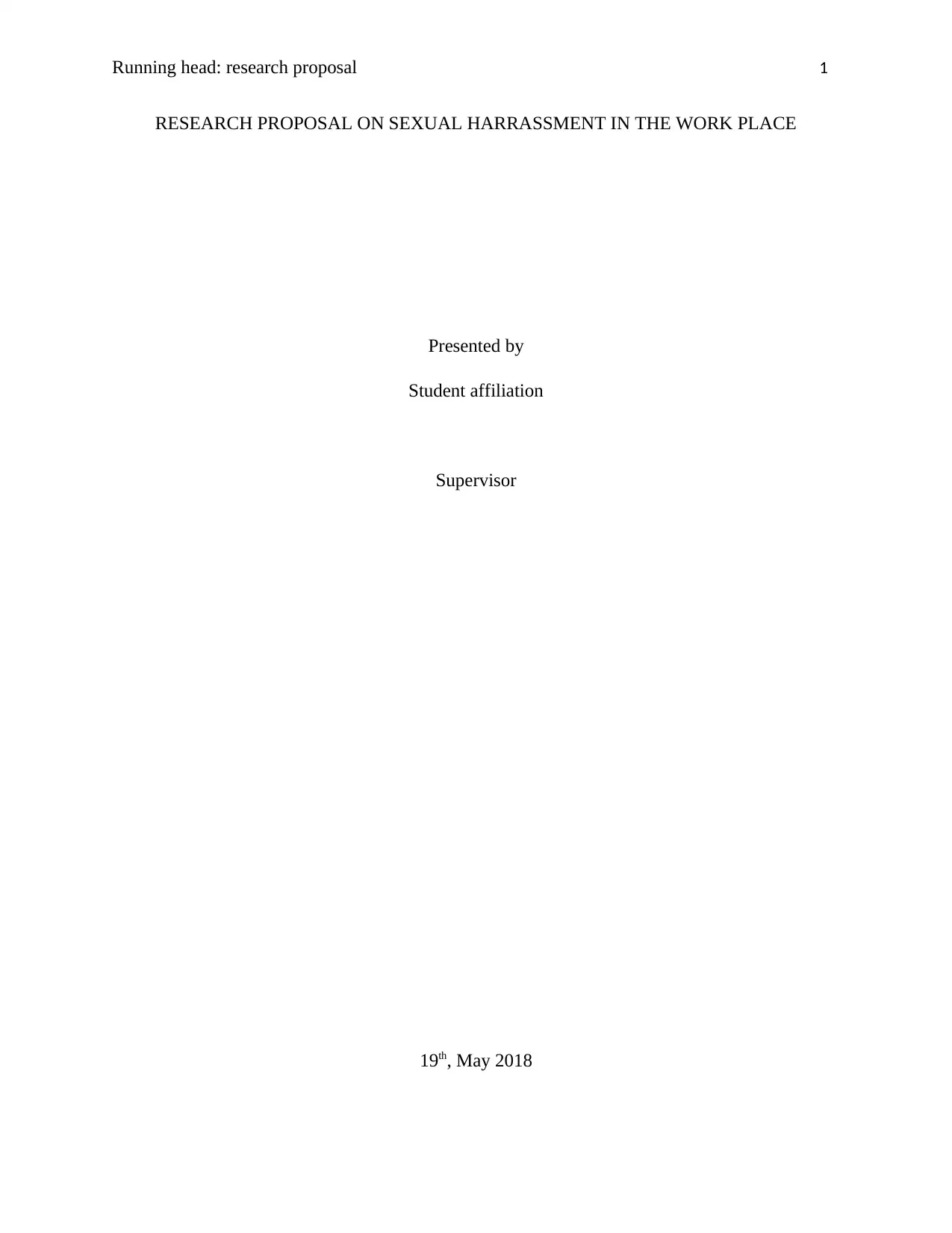
Running head: research proposal 1
RESEARCH PROPOSAL ON SEXUAL HARRASSMENT IN THE WORK PLACE
Presented by
Student affiliation
Supervisor
19th, May 2018
RESEARCH PROPOSAL ON SEXUAL HARRASSMENT IN THE WORK PLACE
Presented by
Student affiliation
Supervisor
19th, May 2018
Paraphrase This Document
Need a fresh take? Get an instant paraphrase of this document with our AI Paraphraser

Running head: research proposal 2
1.0. Introduction
Sexual harassment at workplace is one of negative outcomes that are discouraged in
organizations. Sexual harassments are not only physical in nature they can also be sexually
oriented remarks which are offensive and illegal towards the other gender. In most cases the
victims of sexual harassments are found to be of the female gender. Sexual harassment to the
male gender can occur in the work place but it remains unreported or prosecuted in work places.
Examples of sexual harassments is using inappropriate language, touching on unwanted parts
indecency, and asking for sexual favours (Schneider, Swan, & Fitzgerald, 1997). Organizations
have implemented policies and legislations to curb the problem, and is reported that some
culprits have been prosecuted after being found to have committed sexual harassment.
International manufacturing firm Dubois Industries is facing sexual harassment allegations that
have dented the image of the company (Morral, Gore & Schell, 2016). From the corridor of
justice the company was found guilty of harbouring sexual harassments and was punished.
The allegations of sexual harassment and assault have become an external problem rather than
being an internal problem. Rumours have been spreading within and outside the organization for
several months. It is even reported that cover up is taking place to ensure culprits are not
identified and prosecuted (Lockhart, 2016). In other reports it showed that the organization lacks
leadership morality to curb the problem of sexual harassments. Several media have covered the
story of the company and outlined how it has taken root inside the organization. The culture is
deep rooted and widespread among the employees. The company seeks with consultation with
research experts to maintain its reputation by identifying and making suitable measures and
policies to manage the problem.
1.2. Research objectives and questions
The study is aimed at establishing allegations of sexual harassment misconduct at Dubois
industries. The study is guided by the following research questions:
i. To find out the incidence of sexual harassment at Dubois industries
ii. To establish the nature and causes of sexual harassment at Dubois industries
iii. To identify the suitable policies to curb sexual harassments at Dubois industries
1.0. Introduction
Sexual harassment at workplace is one of negative outcomes that are discouraged in
organizations. Sexual harassments are not only physical in nature they can also be sexually
oriented remarks which are offensive and illegal towards the other gender. In most cases the
victims of sexual harassments are found to be of the female gender. Sexual harassment to the
male gender can occur in the work place but it remains unreported or prosecuted in work places.
Examples of sexual harassments is using inappropriate language, touching on unwanted parts
indecency, and asking for sexual favours (Schneider, Swan, & Fitzgerald, 1997). Organizations
have implemented policies and legislations to curb the problem, and is reported that some
culprits have been prosecuted after being found to have committed sexual harassment.
International manufacturing firm Dubois Industries is facing sexual harassment allegations that
have dented the image of the company (Morral, Gore & Schell, 2016). From the corridor of
justice the company was found guilty of harbouring sexual harassments and was punished.
The allegations of sexual harassment and assault have become an external problem rather than
being an internal problem. Rumours have been spreading within and outside the organization for
several months. It is even reported that cover up is taking place to ensure culprits are not
identified and prosecuted (Lockhart, 2016). In other reports it showed that the organization lacks
leadership morality to curb the problem of sexual harassments. Several media have covered the
story of the company and outlined how it has taken root inside the organization. The culture is
deep rooted and widespread among the employees. The company seeks with consultation with
research experts to maintain its reputation by identifying and making suitable measures and
policies to manage the problem.
1.2. Research objectives and questions
The study is aimed at establishing allegations of sexual harassment misconduct at Dubois
industries. The study is guided by the following research questions:
i. To find out the incidence of sexual harassment at Dubois industries
ii. To establish the nature and causes of sexual harassment at Dubois industries
iii. To identify the suitable policies to curb sexual harassments at Dubois industries
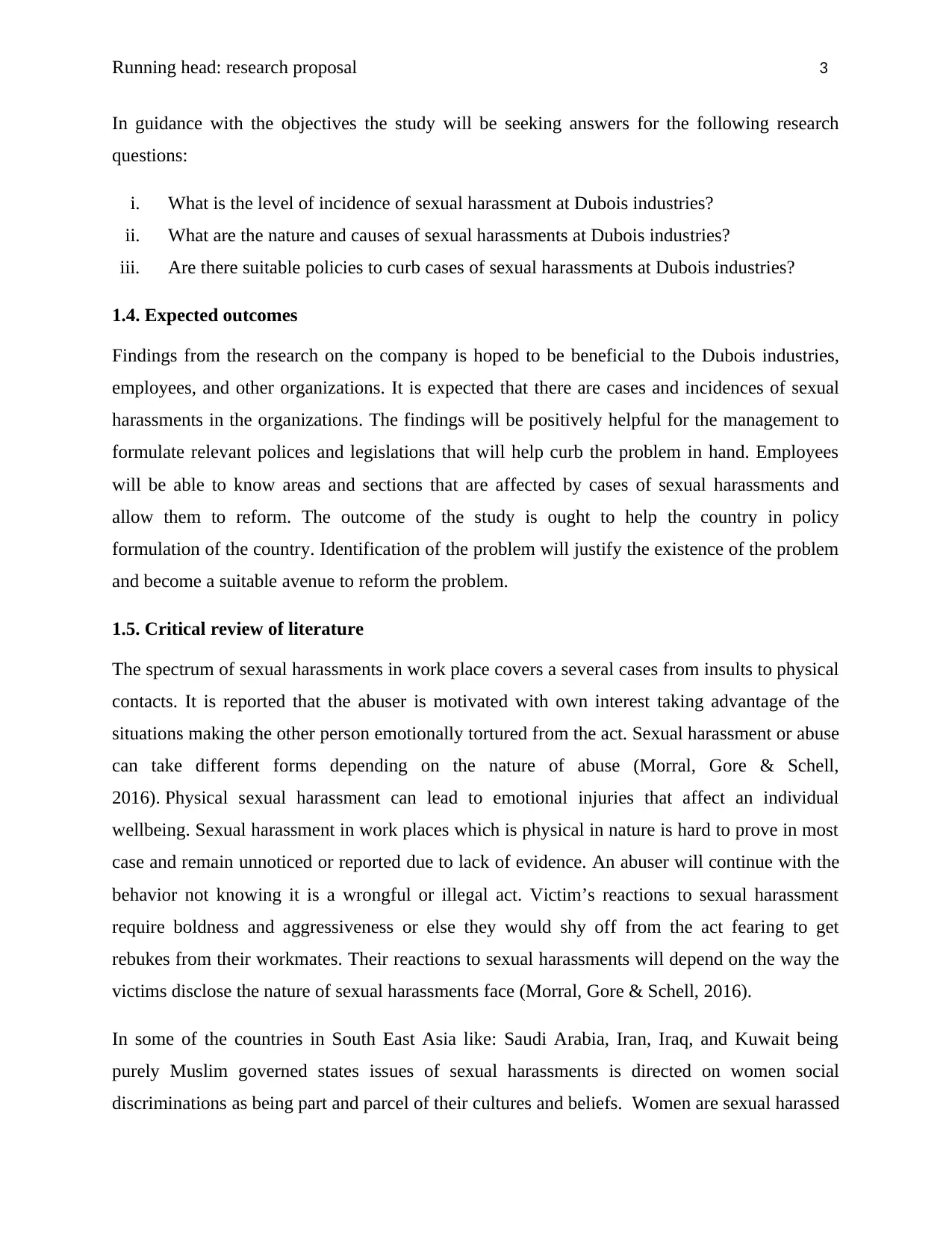
Running head: research proposal 3
In guidance with the objectives the study will be seeking answers for the following research
questions:
i. What is the level of incidence of sexual harassment at Dubois industries?
ii. What are the nature and causes of sexual harassments at Dubois industries?
iii. Are there suitable policies to curb cases of sexual harassments at Dubois industries?
1.4. Expected outcomes
Findings from the research on the company is hoped to be beneficial to the Dubois industries,
employees, and other organizations. It is expected that there are cases and incidences of sexual
harassments in the organizations. The findings will be positively helpful for the management to
formulate relevant polices and legislations that will help curb the problem in hand. Employees
will be able to know areas and sections that are affected by cases of sexual harassments and
allow them to reform. The outcome of the study is ought to help the country in policy
formulation of the country. Identification of the problem will justify the existence of the problem
and become a suitable avenue to reform the problem.
1.5. Critical review of literature
The spectrum of sexual harassments in work place covers a several cases from insults to physical
contacts. It is reported that the abuser is motivated with own interest taking advantage of the
situations making the other person emotionally tortured from the act. Sexual harassment or abuse
can take different forms depending on the nature of abuse (Morral, Gore & Schell,
2016). Physical sexual harassment can lead to emotional injuries that affect an individual
wellbeing. Sexual harassment in work places which is physical in nature is hard to prove in most
case and remain unnoticed or reported due to lack of evidence. An abuser will continue with the
behavior not knowing it is a wrongful or illegal act. Victim’s reactions to sexual harassment
require boldness and aggressiveness or else they would shy off from the act fearing to get
rebukes from their workmates. Their reactions to sexual harassments will depend on the way the
victims disclose the nature of sexual harassments face (Morral, Gore & Schell, 2016).
In some of the countries in South East Asia like: Saudi Arabia, Iran, Iraq, and Kuwait being
purely Muslim governed states issues of sexual harassments is directed on women social
discriminations as being part and parcel of their cultures and beliefs. Women are sexual harassed
In guidance with the objectives the study will be seeking answers for the following research
questions:
i. What is the level of incidence of sexual harassment at Dubois industries?
ii. What are the nature and causes of sexual harassments at Dubois industries?
iii. Are there suitable policies to curb cases of sexual harassments at Dubois industries?
1.4. Expected outcomes
Findings from the research on the company is hoped to be beneficial to the Dubois industries,
employees, and other organizations. It is expected that there are cases and incidences of sexual
harassments in the organizations. The findings will be positively helpful for the management to
formulate relevant polices and legislations that will help curb the problem in hand. Employees
will be able to know areas and sections that are affected by cases of sexual harassments and
allow them to reform. The outcome of the study is ought to help the country in policy
formulation of the country. Identification of the problem will justify the existence of the problem
and become a suitable avenue to reform the problem.
1.5. Critical review of literature
The spectrum of sexual harassments in work place covers a several cases from insults to physical
contacts. It is reported that the abuser is motivated with own interest taking advantage of the
situations making the other person emotionally tortured from the act. Sexual harassment or abuse
can take different forms depending on the nature of abuse (Morral, Gore & Schell,
2016). Physical sexual harassment can lead to emotional injuries that affect an individual
wellbeing. Sexual harassment in work places which is physical in nature is hard to prove in most
case and remain unnoticed or reported due to lack of evidence. An abuser will continue with the
behavior not knowing it is a wrongful or illegal act. Victim’s reactions to sexual harassment
require boldness and aggressiveness or else they would shy off from the act fearing to get
rebukes from their workmates. Their reactions to sexual harassments will depend on the way the
victims disclose the nature of sexual harassments face (Morral, Gore & Schell, 2016).
In some of the countries in South East Asia like: Saudi Arabia, Iran, Iraq, and Kuwait being
purely Muslim governed states issues of sexual harassments is directed on women social
discriminations as being part and parcel of their cultures and beliefs. Women are sexual harassed
⊘ This is a preview!⊘
Do you want full access?
Subscribe today to unlock all pages.

Trusted by 1+ million students worldwide
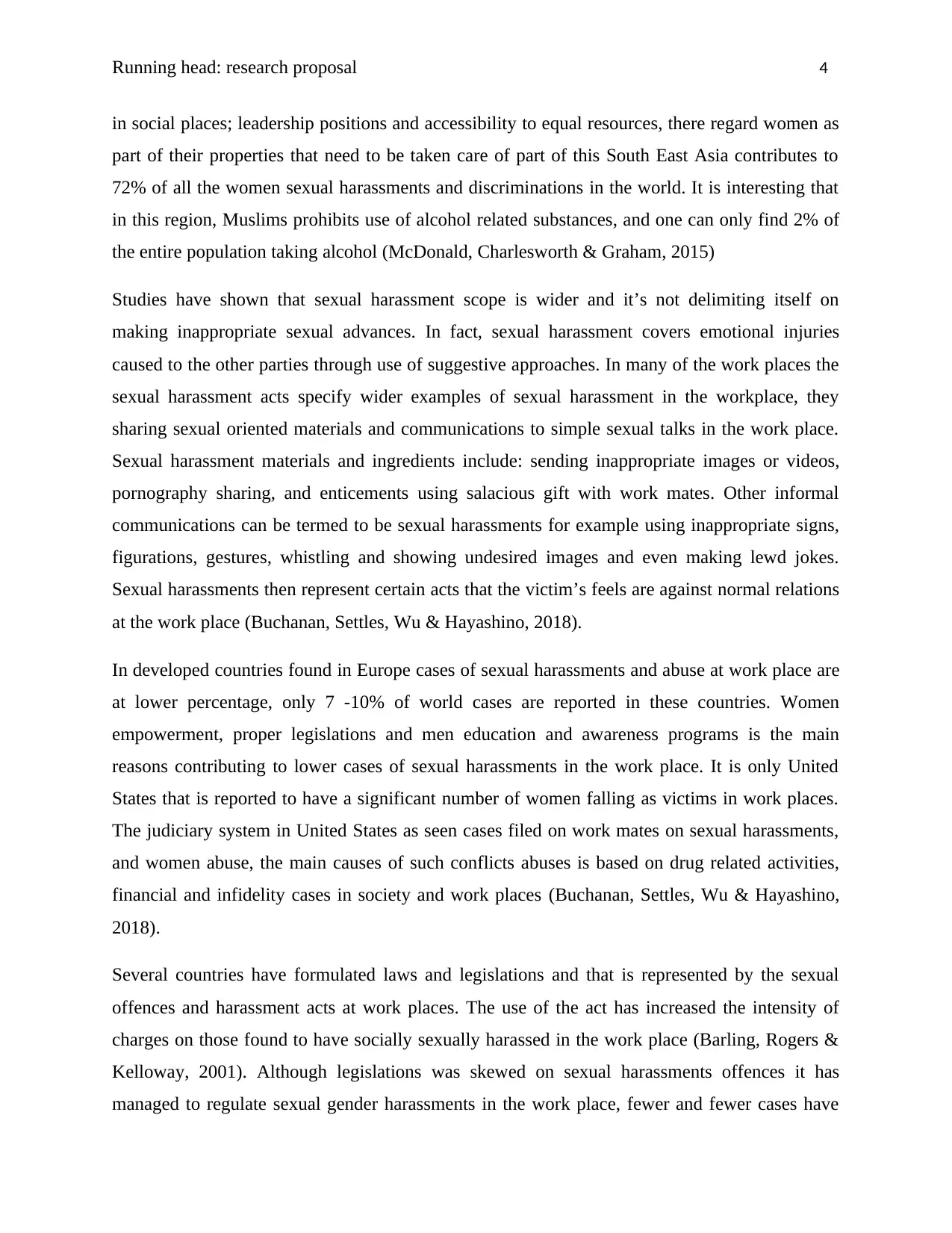
Running head: research proposal 4
in social places; leadership positions and accessibility to equal resources, there regard women as
part of their properties that need to be taken care of part of this South East Asia contributes to
72% of all the women sexual harassments and discriminations in the world. It is interesting that
in this region, Muslims prohibits use of alcohol related substances, and one can only find 2% of
the entire population taking alcohol (McDonald, Charlesworth & Graham, 2015)
Studies have shown that sexual harassment scope is wider and it’s not delimiting itself on
making inappropriate sexual advances. In fact, sexual harassment covers emotional injuries
caused to the other parties through use of suggestive approaches. In many of the work places the
sexual harassment acts specify wider examples of sexual harassment in the workplace, they
sharing sexual oriented materials and communications to simple sexual talks in the work place.
Sexual harassment materials and ingredients include: sending inappropriate images or videos,
pornography sharing, and enticements using salacious gift with work mates. Other informal
communications can be termed to be sexual harassments for example using inappropriate signs,
figurations, gestures, whistling and showing undesired images and even making lewd jokes.
Sexual harassments then represent certain acts that the victim’s feels are against normal relations
at the work place (Buchanan, Settles, Wu & Hayashino, 2018).
In developed countries found in Europe cases of sexual harassments and abuse at work place are
at lower percentage, only 7 -10% of world cases are reported in these countries. Women
empowerment, proper legislations and men education and awareness programs is the main
reasons contributing to lower cases of sexual harassments in the work place. It is only United
States that is reported to have a significant number of women falling as victims in work places.
The judiciary system in United States as seen cases filed on work mates on sexual harassments,
and women abuse, the main causes of such conflicts abuses is based on drug related activities,
financial and infidelity cases in society and work places (Buchanan, Settles, Wu & Hayashino,
2018).
Several countries have formulated laws and legislations and that is represented by the sexual
offences and harassment acts at work places. The use of the act has increased the intensity of
charges on those found to have socially sexually harassed in the work place (Barling, Rogers &
Kelloway, 2001). Although legislations was skewed on sexual harassments offences it has
managed to regulate sexual gender harassments in the work place, fewer and fewer cases have
in social places; leadership positions and accessibility to equal resources, there regard women as
part of their properties that need to be taken care of part of this South East Asia contributes to
72% of all the women sexual harassments and discriminations in the world. It is interesting that
in this region, Muslims prohibits use of alcohol related substances, and one can only find 2% of
the entire population taking alcohol (McDonald, Charlesworth & Graham, 2015)
Studies have shown that sexual harassment scope is wider and it’s not delimiting itself on
making inappropriate sexual advances. In fact, sexual harassment covers emotional injuries
caused to the other parties through use of suggestive approaches. In many of the work places the
sexual harassment acts specify wider examples of sexual harassment in the workplace, they
sharing sexual oriented materials and communications to simple sexual talks in the work place.
Sexual harassment materials and ingredients include: sending inappropriate images or videos,
pornography sharing, and enticements using salacious gift with work mates. Other informal
communications can be termed to be sexual harassments for example using inappropriate signs,
figurations, gestures, whistling and showing undesired images and even making lewd jokes.
Sexual harassments then represent certain acts that the victim’s feels are against normal relations
at the work place (Buchanan, Settles, Wu & Hayashino, 2018).
In developed countries found in Europe cases of sexual harassments and abuse at work place are
at lower percentage, only 7 -10% of world cases are reported in these countries. Women
empowerment, proper legislations and men education and awareness programs is the main
reasons contributing to lower cases of sexual harassments in the work place. It is only United
States that is reported to have a significant number of women falling as victims in work places.
The judiciary system in United States as seen cases filed on work mates on sexual harassments,
and women abuse, the main causes of such conflicts abuses is based on drug related activities,
financial and infidelity cases in society and work places (Buchanan, Settles, Wu & Hayashino,
2018).
Several countries have formulated laws and legislations and that is represented by the sexual
offences and harassment acts at work places. The use of the act has increased the intensity of
charges on those found to have socially sexually harassed in the work place (Barling, Rogers &
Kelloway, 2001). Although legislations was skewed on sexual harassments offences it has
managed to regulate sexual gender harassments in the work place, fewer and fewer cases have
Paraphrase This Document
Need a fresh take? Get an instant paraphrase of this document with our AI Paraphraser
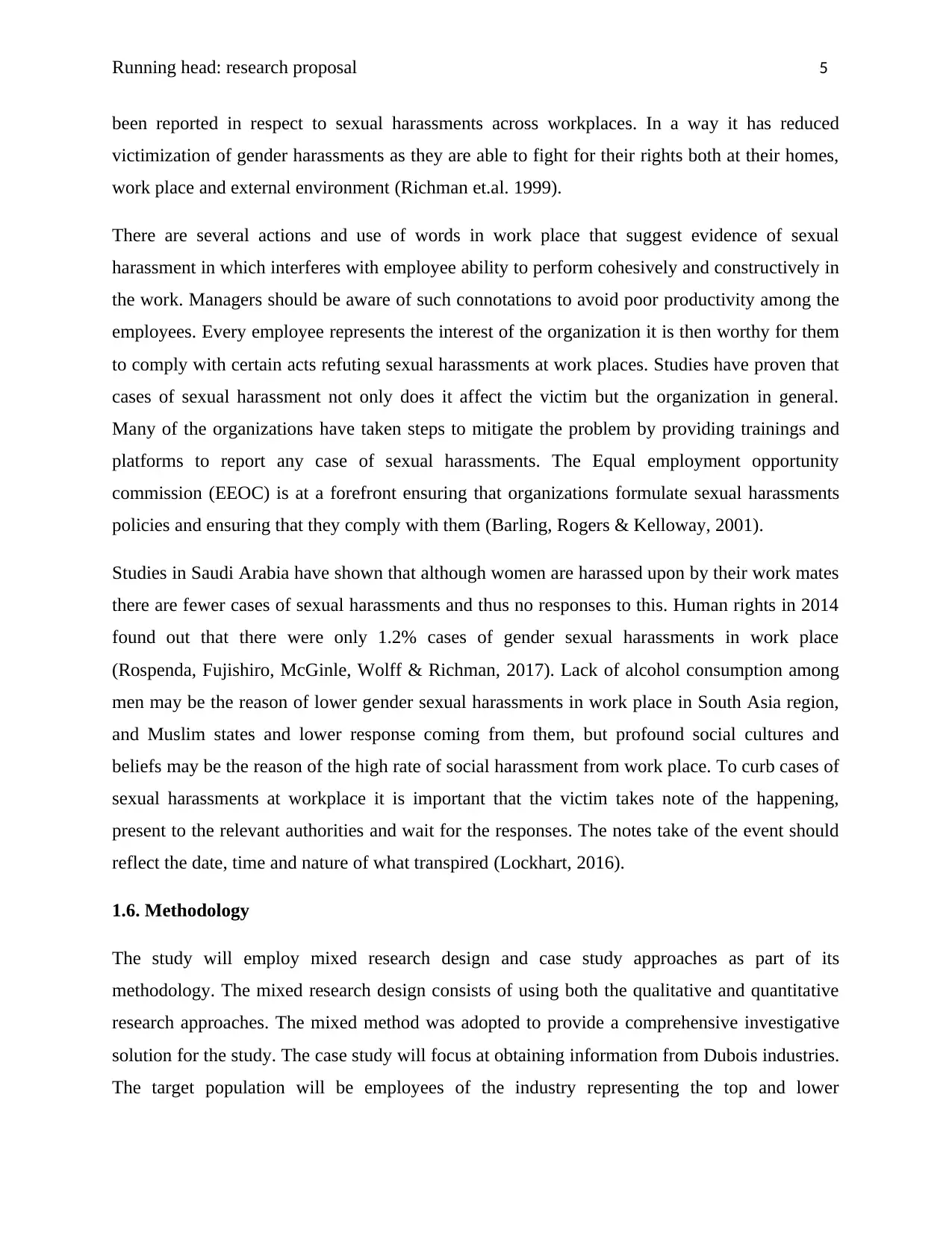
Running head: research proposal 5
been reported in respect to sexual harassments across workplaces. In a way it has reduced
victimization of gender harassments as they are able to fight for their rights both at their homes,
work place and external environment (Richman et.al. 1999).
There are several actions and use of words in work place that suggest evidence of sexual
harassment in which interferes with employee ability to perform cohesively and constructively in
the work. Managers should be aware of such connotations to avoid poor productivity among the
employees. Every employee represents the interest of the organization it is then worthy for them
to comply with certain acts refuting sexual harassments at work places. Studies have proven that
cases of sexual harassment not only does it affect the victim but the organization in general.
Many of the organizations have taken steps to mitigate the problem by providing trainings and
platforms to report any case of sexual harassments. The Equal employment opportunity
commission (EEOC) is at a forefront ensuring that organizations formulate sexual harassments
policies and ensuring that they comply with them (Barling, Rogers & Kelloway, 2001).
Studies in Saudi Arabia have shown that although women are harassed upon by their work mates
there are fewer cases of sexual harassments and thus no responses to this. Human rights in 2014
found out that there were only 1.2% cases of gender sexual harassments in work place
(Rospenda, Fujishiro, McGinle, Wolff & Richman, 2017). Lack of alcohol consumption among
men may be the reason of lower gender sexual harassments in work place in South Asia region,
and Muslim states and lower response coming from them, but profound social cultures and
beliefs may be the reason of the high rate of social harassment from work place. To curb cases of
sexual harassments at workplace it is important that the victim takes note of the happening,
present to the relevant authorities and wait for the responses. The notes take of the event should
reflect the date, time and nature of what transpired (Lockhart, 2016).
1.6. Methodology
The study will employ mixed research design and case study approaches as part of its
methodology. The mixed research design consists of using both the qualitative and quantitative
research approaches. The mixed method was adopted to provide a comprehensive investigative
solution for the study. The case study will focus at obtaining information from Dubois industries.
The target population will be employees of the industry representing the top and lower
been reported in respect to sexual harassments across workplaces. In a way it has reduced
victimization of gender harassments as they are able to fight for their rights both at their homes,
work place and external environment (Richman et.al. 1999).
There are several actions and use of words in work place that suggest evidence of sexual
harassment in which interferes with employee ability to perform cohesively and constructively in
the work. Managers should be aware of such connotations to avoid poor productivity among the
employees. Every employee represents the interest of the organization it is then worthy for them
to comply with certain acts refuting sexual harassments at work places. Studies have proven that
cases of sexual harassment not only does it affect the victim but the organization in general.
Many of the organizations have taken steps to mitigate the problem by providing trainings and
platforms to report any case of sexual harassments. The Equal employment opportunity
commission (EEOC) is at a forefront ensuring that organizations formulate sexual harassments
policies and ensuring that they comply with them (Barling, Rogers & Kelloway, 2001).
Studies in Saudi Arabia have shown that although women are harassed upon by their work mates
there are fewer cases of sexual harassments and thus no responses to this. Human rights in 2014
found out that there were only 1.2% cases of gender sexual harassments in work place
(Rospenda, Fujishiro, McGinle, Wolff & Richman, 2017). Lack of alcohol consumption among
men may be the reason of lower gender sexual harassments in work place in South Asia region,
and Muslim states and lower response coming from them, but profound social cultures and
beliefs may be the reason of the high rate of social harassment from work place. To curb cases of
sexual harassments at workplace it is important that the victim takes note of the happening,
present to the relevant authorities and wait for the responses. The notes take of the event should
reflect the date, time and nature of what transpired (Lockhart, 2016).
1.6. Methodology
The study will employ mixed research design and case study approaches as part of its
methodology. The mixed research design consists of using both the qualitative and quantitative
research approaches. The mixed method was adopted to provide a comprehensive investigative
solution for the study. The case study will focus at obtaining information from Dubois industries.
The target population will be employees of the industry representing the top and lower
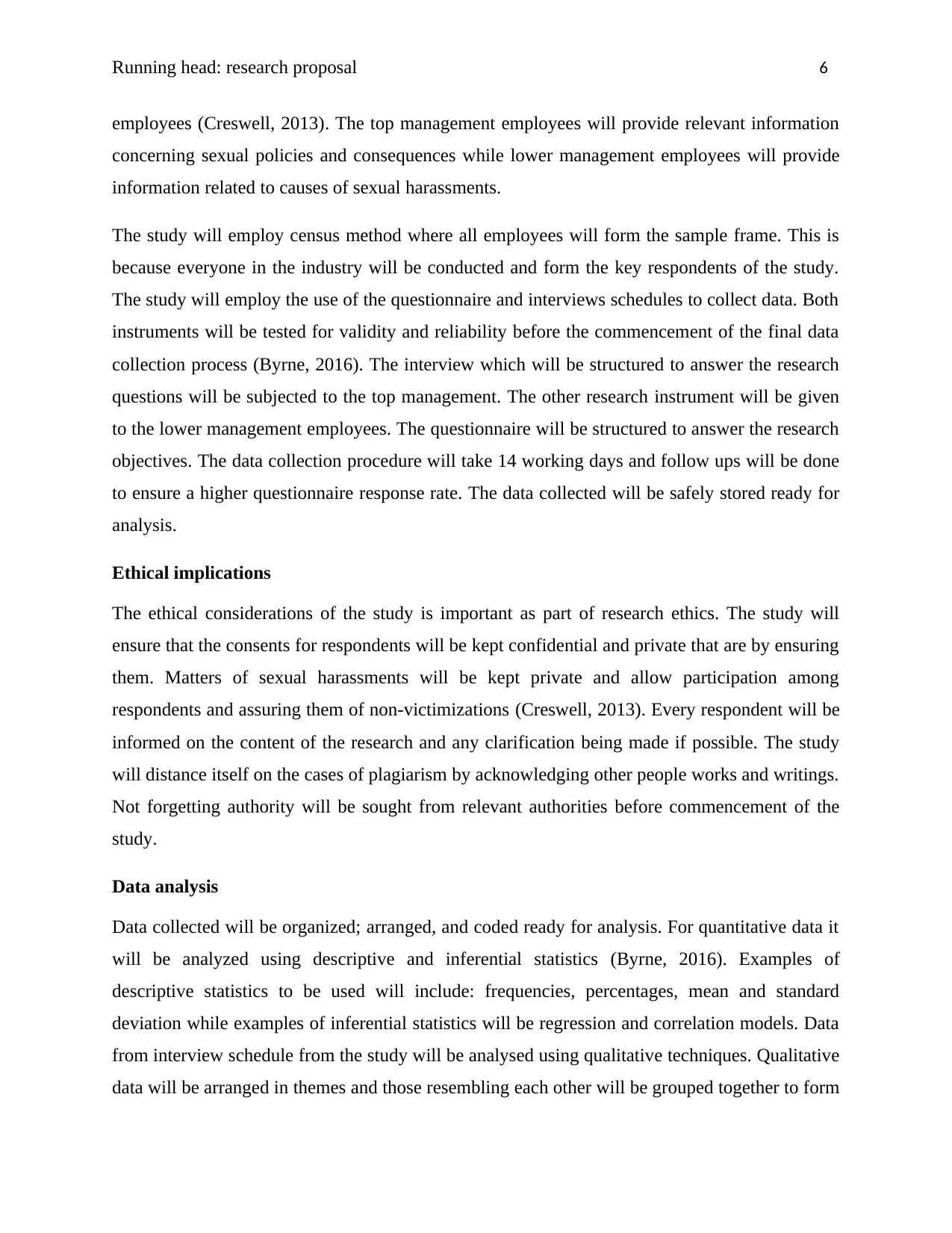
Running head: research proposal 6
employees (Creswell, 2013). The top management employees will provide relevant information
concerning sexual policies and consequences while lower management employees will provide
information related to causes of sexual harassments.
The study will employ census method where all employees will form the sample frame. This is
because everyone in the industry will be conducted and form the key respondents of the study.
The study will employ the use of the questionnaire and interviews schedules to collect data. Both
instruments will be tested for validity and reliability before the commencement of the final data
collection process (Byrne, 2016). The interview which will be structured to answer the research
questions will be subjected to the top management. The other research instrument will be given
to the lower management employees. The questionnaire will be structured to answer the research
objectives. The data collection procedure will take 14 working days and follow ups will be done
to ensure a higher questionnaire response rate. The data collected will be safely stored ready for
analysis.
Ethical implications
The ethical considerations of the study is important as part of research ethics. The study will
ensure that the consents for respondents will be kept confidential and private that are by ensuring
them. Matters of sexual harassments will be kept private and allow participation among
respondents and assuring them of non-victimizations (Creswell, 2013). Every respondent will be
informed on the content of the research and any clarification being made if possible. The study
will distance itself on the cases of plagiarism by acknowledging other people works and writings.
Not forgetting authority will be sought from relevant authorities before commencement of the
study.
Data analysis
Data collected will be organized; arranged, and coded ready for analysis. For quantitative data it
will be analyzed using descriptive and inferential statistics (Byrne, 2016). Examples of
descriptive statistics to be used will include: frequencies, percentages, mean and standard
deviation while examples of inferential statistics will be regression and correlation models. Data
from interview schedule from the study will be analysed using qualitative techniques. Qualitative
data will be arranged in themes and those resembling each other will be grouped together to form
employees (Creswell, 2013). The top management employees will provide relevant information
concerning sexual policies and consequences while lower management employees will provide
information related to causes of sexual harassments.
The study will employ census method where all employees will form the sample frame. This is
because everyone in the industry will be conducted and form the key respondents of the study.
The study will employ the use of the questionnaire and interviews schedules to collect data. Both
instruments will be tested for validity and reliability before the commencement of the final data
collection process (Byrne, 2016). The interview which will be structured to answer the research
questions will be subjected to the top management. The other research instrument will be given
to the lower management employees. The questionnaire will be structured to answer the research
objectives. The data collection procedure will take 14 working days and follow ups will be done
to ensure a higher questionnaire response rate. The data collected will be safely stored ready for
analysis.
Ethical implications
The ethical considerations of the study is important as part of research ethics. The study will
ensure that the consents for respondents will be kept confidential and private that are by ensuring
them. Matters of sexual harassments will be kept private and allow participation among
respondents and assuring them of non-victimizations (Creswell, 2013). Every respondent will be
informed on the content of the research and any clarification being made if possible. The study
will distance itself on the cases of plagiarism by acknowledging other people works and writings.
Not forgetting authority will be sought from relevant authorities before commencement of the
study.
Data analysis
Data collected will be organized; arranged, and coded ready for analysis. For quantitative data it
will be analyzed using descriptive and inferential statistics (Byrne, 2016). Examples of
descriptive statistics to be used will include: frequencies, percentages, mean and standard
deviation while examples of inferential statistics will be regression and correlation models. Data
from interview schedule from the study will be analysed using qualitative techniques. Qualitative
data will be arranged in themes and those resembling each other will be grouped together to form
⊘ This is a preview!⊘
Do you want full access?
Subscribe today to unlock all pages.

Trusted by 1+ million students worldwide

Running head: research proposal 7
meaningful statements. Final report thesis will be documented after the analysis has been done
documenting the findings and recommendations of the study.
meaningful statements. Final report thesis will be documented after the analysis has been done
documenting the findings and recommendations of the study.
Paraphrase This Document
Need a fresh take? Get an instant paraphrase of this document with our AI Paraphraser

Running head: research proposal 8
References
Barling, J., Rogers, A. G., & Kelloway, E. K. (2001). Behind closed doors: In-home workers’
experience of sexual harassment and workplace violence. Journal of Occupational Health
Psychology, 6(3), 255-269.
Byrne, D. (2016). Interpreting Quantitative Data. New Dheli: India: SAGE.
Buchanan, N. T., Settles, I. H., Wu, I. H., & Hayashino, D. S. (2018). Sexual Harassment, Racial
Harassment, and Well-being among Asian American Women: An Intersectional
Approach. Women & Therapy, 1-20.
Creswell, J. W. (2013). Research Design: Qualitative, Quantitative, and Mixed Methods
Approaches. SAGE Publication.
McDonald, P., Charlesworth, S., & Graham, T. (2015). Developing a framework of effective
prevention and response strategies in workplace sexual harassment. Asia Pacific Journal of
Human Resources, 53(1), 41-58.
Morral, A. R., Gore, K. L., & Schell, T. L. (2016). Sexual Assault and Sexual Harassment in the
US Military: Evaluating Estimates from the 2014 RAND Military Workplace Study (No.
RB-989 (2016)). RAND National Defense Research Institute Santa Monica.
Lockhart, L. (2016). Sexual harassment in the workplace. Nursing Made Incredibly Easy, 14(6),
55.
Richman, J. A., Rospenda, K. M., Nawyn, S. J., Flaherty, J. A., Fendrich, M., Drum, M. L., &
Johnson, T. P. (1999). Sexual harassment and generalized workplace abuse among
university employees: Prevalence and mental health correlates. American Journal of Public
Health, 89(3), 358-363.
Rospenda, K. M., Fujishiro, K., McGinley, M., Wolff, J. M., & Richman, J. A. (2017). Effects of
workplace generalized and sexual harassment on abusive drinking among first year male
and female college students: does prior drinking experience matter?. Substance use &
misuse, 52(7), 892-904.
References
Barling, J., Rogers, A. G., & Kelloway, E. K. (2001). Behind closed doors: In-home workers’
experience of sexual harassment and workplace violence. Journal of Occupational Health
Psychology, 6(3), 255-269.
Byrne, D. (2016). Interpreting Quantitative Data. New Dheli: India: SAGE.
Buchanan, N. T., Settles, I. H., Wu, I. H., & Hayashino, D. S. (2018). Sexual Harassment, Racial
Harassment, and Well-being among Asian American Women: An Intersectional
Approach. Women & Therapy, 1-20.
Creswell, J. W. (2013). Research Design: Qualitative, Quantitative, and Mixed Methods
Approaches. SAGE Publication.
McDonald, P., Charlesworth, S., & Graham, T. (2015). Developing a framework of effective
prevention and response strategies in workplace sexual harassment. Asia Pacific Journal of
Human Resources, 53(1), 41-58.
Morral, A. R., Gore, K. L., & Schell, T. L. (2016). Sexual Assault and Sexual Harassment in the
US Military: Evaluating Estimates from the 2014 RAND Military Workplace Study (No.
RB-989 (2016)). RAND National Defense Research Institute Santa Monica.
Lockhart, L. (2016). Sexual harassment in the workplace. Nursing Made Incredibly Easy, 14(6),
55.
Richman, J. A., Rospenda, K. M., Nawyn, S. J., Flaherty, J. A., Fendrich, M., Drum, M. L., &
Johnson, T. P. (1999). Sexual harassment and generalized workplace abuse among
university employees: Prevalence and mental health correlates. American Journal of Public
Health, 89(3), 358-363.
Rospenda, K. M., Fujishiro, K., McGinley, M., Wolff, J. M., & Richman, J. A. (2017). Effects of
workplace generalized and sexual harassment on abusive drinking among first year male
and female college students: does prior drinking experience matter?. Substance use &
misuse, 52(7), 892-904.

Running head: research proposal 9
Schneider, K. T., Swan, S., & Fitzgerald, L. F. (1997). Job-related and psychological effects of
sexual harassment in the workplace: Empirical evidence from two organizations: Journal of
Applied Psychology, 82(3), 401-415.
Appendixes
Appendix i: Budget
Schneider, K. T., Swan, S., & Fitzgerald, L. F. (1997). Job-related and psychological effects of
sexual harassment in the workplace: Empirical evidence from two organizations: Journal of
Applied Psychology, 82(3), 401-415.
Appendixes
Appendix i: Budget
⊘ This is a preview!⊘
Do you want full access?
Subscribe today to unlock all pages.

Trusted by 1+ million students worldwide
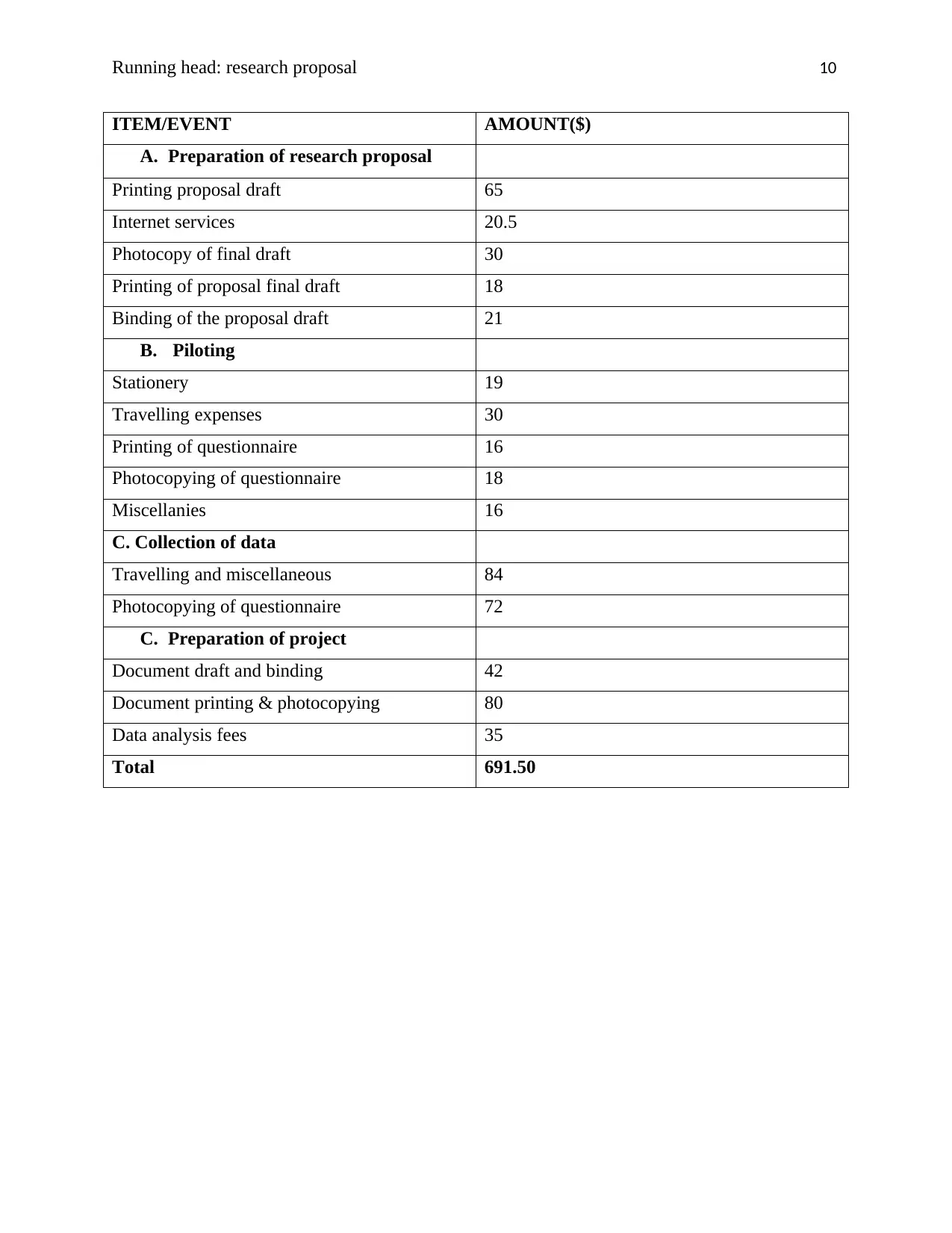
Running head: research proposal 10
ITEM/EVENT AMOUNT($)
A. Preparation of research proposal
Printing proposal draft 65
Internet services 20.5
Photocopy of final draft 30
Printing of proposal final draft 18
Binding of the proposal draft 21
B. Piloting
Stationery 19
Travelling expenses 30
Printing of questionnaire 16
Photocopying of questionnaire 18
Miscellanies 16
C. Collection of data
Travelling and miscellaneous 84
Photocopying of questionnaire 72
C. Preparation of project
Document draft and binding 42
Document printing & photocopying 80
Data analysis fees 35
Total 691.50
ITEM/EVENT AMOUNT($)
A. Preparation of research proposal
Printing proposal draft 65
Internet services 20.5
Photocopy of final draft 30
Printing of proposal final draft 18
Binding of the proposal draft 21
B. Piloting
Stationery 19
Travelling expenses 30
Printing of questionnaire 16
Photocopying of questionnaire 18
Miscellanies 16
C. Collection of data
Travelling and miscellaneous 84
Photocopying of questionnaire 72
C. Preparation of project
Document draft and binding 42
Document printing & photocopying 80
Data analysis fees 35
Total 691.50
Paraphrase This Document
Need a fresh take? Get an instant paraphrase of this document with our AI Paraphraser

Running head: research proposal 11
Appendix ii: Research schedule
ITEM MARCH APRIL MAY JUNE JULY
Proposal
Collection of data
Analysis and thesis defense
Thesis final submission
Appendix ii: Research schedule
ITEM MARCH APRIL MAY JUNE JULY
Proposal
Collection of data
Analysis and thesis defense
Thesis final submission
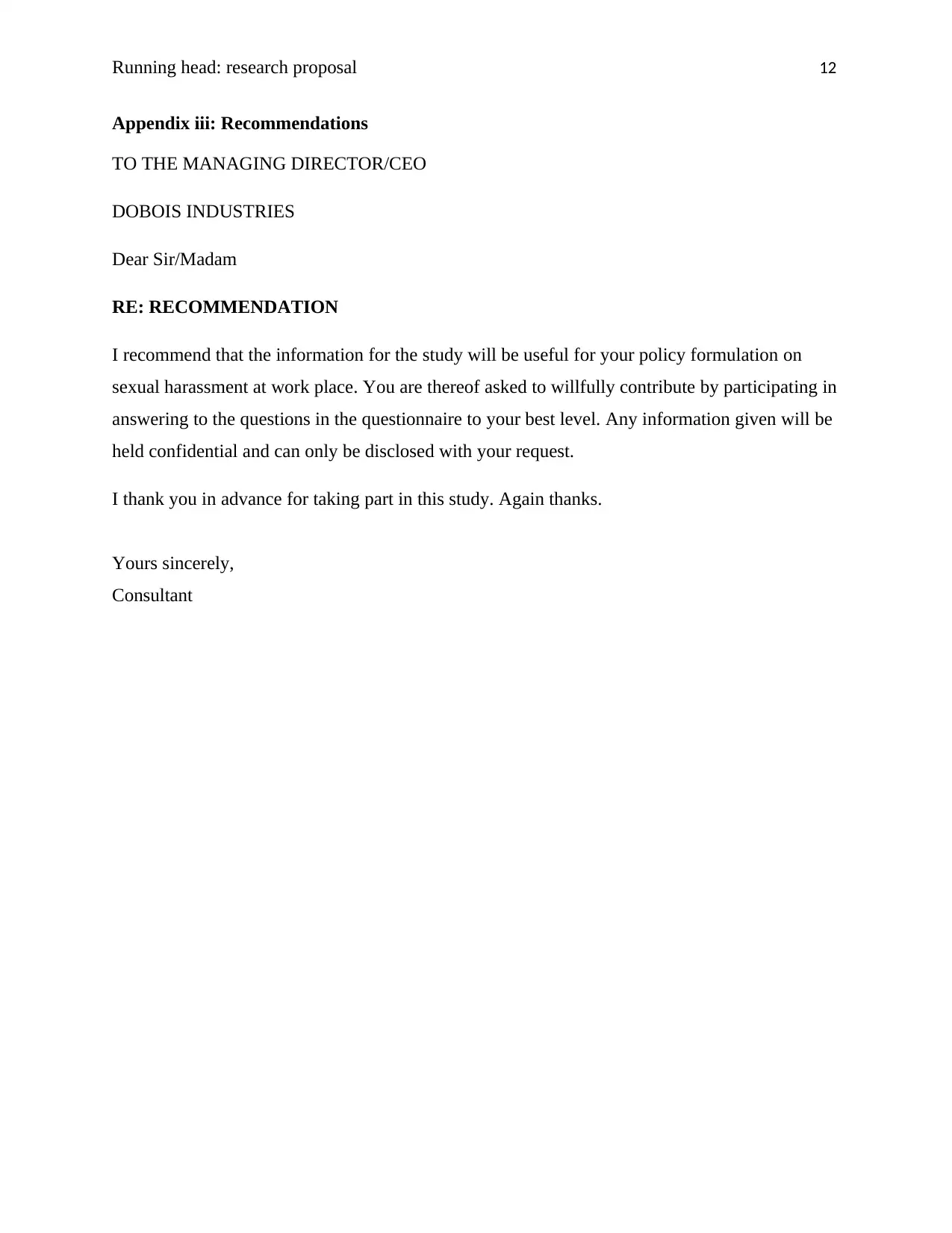
Running head: research proposal 12
Appendix iii: Recommendations
TO THE MANAGING DIRECTOR/CEO
DOBOIS INDUSTRIES
Dear Sir/Madam
RE: RECOMMENDATION
I recommend that the information for the study will be useful for your policy formulation on
sexual harassment at work place. You are thereof asked to willfully contribute by participating in
answering to the questions in the questionnaire to your best level. Any information given will be
held confidential and can only be disclosed with your request.
I thank you in advance for taking part in this study. Again thanks.
Yours sincerely,
Consultant
Appendix iii: Recommendations
TO THE MANAGING DIRECTOR/CEO
DOBOIS INDUSTRIES
Dear Sir/Madam
RE: RECOMMENDATION
I recommend that the information for the study will be useful for your policy formulation on
sexual harassment at work place. You are thereof asked to willfully contribute by participating in
answering to the questions in the questionnaire to your best level. Any information given will be
held confidential and can only be disclosed with your request.
I thank you in advance for taking part in this study. Again thanks.
Yours sincerely,
Consultant
⊘ This is a preview!⊘
Do you want full access?
Subscribe today to unlock all pages.

Trusted by 1+ million students worldwide
1 out of 12
Related Documents
Your All-in-One AI-Powered Toolkit for Academic Success.
+13062052269
info@desklib.com
Available 24*7 on WhatsApp / Email
![[object Object]](/_next/static/media/star-bottom.7253800d.svg)
Unlock your academic potential
Copyright © 2020–2025 A2Z Services. All Rights Reserved. Developed and managed by ZUCOL.





